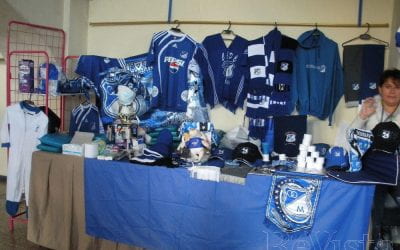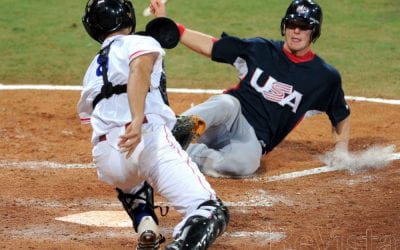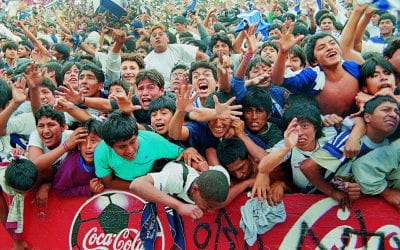While traveling from Michigan to Boston in July 2010, my family stopped for the night in Batavia, NY, and discovered a baseball game was about to begin. My 16-year-old daughter Darcy and I hustled over to Dwyer Stadium to catch the Batavia Muckdogs play the Hudson Valley Renegades, from Wapsinger Falls, NY.
This was the New York-Penn Class A Short Season League, the lowest level of the minor leagues. The players had been signed and paid for by Major League teams: the St. Louis Cardinals (Muckdogs) and the Tampa Bay Rays (Renegades).
A balmy night brought out a lively crowd of about a thousand fans. Front row seats were $7. Corn dogs, pizza, and beer were on offer; a bizarre-looking mascot cavorted. Between innings were contests, public service awards, raffle winners, and promotions—all animated by a boisterous announcer.
Most of the players on the field appeared to be white kids just past high school age. But a substantial number did not. Our program revealed that both shortstops came from the Dominican Republic; both catchers were Latino (DR and Venezuela), both third basemen were Puerto Ricans; the two first basemen were from California (Sánchez and Tinoco), and a Renegade relief pitcher was Venezuelan. The right fielder was named Burt Reynolds. We initially failed to notice that the program said he was Dominican.
That changed when Reynolds, with a laser beam throw to third base, caught Muckdog slugger Bergman trying to turn a double into a triple. Three innings later Reynolds drove in two runs with a rocket homerun over the right center field fence. Nonetheless, the Muckdogs defeated the Renegades 9-3.
We wondered after the game about the story behind that movie star name.
When I returned to work at the University of Massachusetts Boston, I asked my Dominican friend, maintenance man, and sage, Milton Mejias: “How weird is it that a Dominican not only gets two Anglo names but even gets to be a movie star’s namesake?”
Milton pointed out that Burt Reynolds was from San Pedro de Macorís—a small city near Santo Domingo now legendary for its production of major and minor league players. San Pedro, Milton told me, had been a sugar-producing center going back to the 19th century. The plantation owners had imported workers from English-speaking Caribbean islands. So, Milton explained, in San Pedro, not only are English names frequent but it remains common to hear people speaking English.
Still, I wondered about the movie star name. And I had been curious about why the Dominican Republic, a country of only ten million, and San Pedro de Macorís in particular, had so many major and minor league players.
The Renegades had released Burt Reynolds at the end of the 2010 season. This was his fourth year in the minors. He had shown some power hitting and speed, but his strikeouts were many; his walks few. We might have seen him on his best night.
I could not find him on 2011 minor league rosters. Nor was he listed on any of the Dominican professional league teams that play during the winter. I wrote and called the Renegades to locate him, but without results. So I tried a sportswriter for thePoughkeepsie Journal who suggested I get in touch with Robinson Canó, the superstar New York Yankee second baseman, because Reynolds is his cousin. (Canó won the homerun derby at the All-Star Game last summer, as his father José pitched to him. José had had a brief Major League pitching career, and ran a baseball academy.) But I could not find a website or telephone number, so I paused in the Burt Reynolds search.
Why so many Dominicans? The proportions are astounding. The DR, with a current population of ten million, has had 543 players appear in at least one Major League game. That’s more than the next two Latin sources combined: Venezuela, with 270, and Puerto Rico, with 233. But the DR did not get its first player into the big leagues until 1956, decades after Cuba, Mexico, Puerto Rico and Venezuela. (Panama, Nicaragua, and Colombia have been smaller sources.) Though baseball’s origins differ by country, it will not be lost on ReVista readers that the list corresponds to places invaded by U.S. troops.
Of players who debuted in the majors since 2000, the DR with 252 has far more than climate-friendly Florida (163), a state nearly twice its size, and 75% as many as California, a state nearly 4 times its size.
San Pedro de Macorís, a city of 220,000, has had 86 players make it to the majors, surpassed in the DR only by Santo Domingo, with 125 players, a city 10 times its size. Is it the water?
A combination of international politics, economics and Major League baseball rules partly explains the Dominican, if not the San Pedro de Macorís, phenomenon. Cuba had long been the dominant Latin baseball power. The first Dominican Major League player, Ozzie Virgil, did not debut until 1956. By contrast, the first Cuban player came in 1911, and players came from Mexico, Venezuela and Puerto Rico between 1933 and 1942.
By 1947, Cuba had sent 39 more to the Majors. But they had to be fair-skinned Cubans. Jackie Robinson broke the color line in 1947 with the Brooklyn Dodgers and Larry Doby joined the Cleveland Indians two months later. In 1949 Cuban-born Saturnino “Minnie” Minoso became the first Black Latin in the majors, a boyhood favorite of mine when he played for the Chicago White Sox. In the ten years following the Cuban Revolution, three dozen Cuban-born men came to the majors (twice as many as Dominicans), almost all of them previously U.S. residents. But in the next 30 years only two dozen Cubans made the majors, compared to 276 Dominicans.
Dominican (and Venezuelan) players came to have an advantage over Puerto Ricans because Major League Baseball applied U.S. rules for drafting young players to Puerto Rico, but not to other Latin sources. This made it possible for teams to sign Dominicans at younger ages and lower prices. In the last ten years Major League debuts from Puerto Rico declined 25%. They expanded 50% from Venezuela and the DR.
Relative to other Latin sources, baseball culture has “thickened” in the DR due to several factors. The Dominican players have filled a vacuum left by Cuba and to a lesser extent Puerto Rico. Compared to Venezuela, its baseball talent is geographically compressed. Its population is nearly 40% that of Venezuela; its land size is but 5% that of Venezuela. Its economic resources and diversity are far less than Venezuela’s, so opportunities are fewer for young men.
Following the 1956 debut of Ozzie Virgil, through 1965 only seventeen Dominicans made it to the majors. Six were from San Pedro. San Pedro’s historic sugar economy had only seasonal work. After the harvest, they played baseball on teams organized around sugar mills. San Pedro was primed for the Dominican leap to the majors.
Success and numbers contributed to this “thickening.” Of the first seventeen players, eight had very long Major League careers (ranging from 13 to 21 years), and six became stars (the three Alou brothers, Manny Mota, Rico Carty, and the incomparable Juan Marichal, a Hall of Famer), making for an amazing record of success. With legends in their midst, baseball became a way out for young men. Even though minor league wages are quite low, they are considerably more than what young men with limited education can make in the Dominican Republic. And Major League salaries exploded after the 1970s.
But minor league wages last only for a few months during the season. In sharp contrast to the DR’s first decade of success, the vast majority never makes it to the majors. And life can be difficult for Latin Americans in the minor leagues—as illustrated in the poignant film Sugar (2008).
A Dominican player, Miguel “Sugar” Santos (Algenis Pérez Soto), is assigned to a lower-level minor league team in a small city in rural Iowa. His English is limited. He lives with a local family, well-meaning but with little background in things Latin American. His coach speaks to him as if Sugar understood English. After some early-season pitching success, Sugar runs into a rough patch and some hostility. He bolts from the team, finds his way to New York, and, with his visa expired, gets a job washing dishes. He finds some redemption, playing ball in pickup games in Central Park with other Latinos.
This story is not overdramatized. Sugar could call home on his cell. The Dominican great Pedro Martínez was assigned to the wilderness of Great Falls, Montana, in the pre-cell days of 1990. Visas for minor league players expire at the end of the season and some, like Sugar, who have not had enough success disappear into the big cities.
I wondered if this might have been the case with Burt Reynolds. Then I discovered through another web search that Burt played last summer for the Newark Bears in the independent Canadian-American league. Independent teams have no affiliation with Major League teams, so they have to pay their players out of ticket sales (perhaps $800 to $2,000 a month, more if they have Major League experience). Rosters are filled with players hoping to get into the minor leagues, to be late bloomers, and a few former major leaguers hoping for one last shot.
I called the Bears—a team that began in Newark in 1917—and was directed to Buddy Caruso, Business Manager, Concessions Director and jack-of-all-trades. He gave me Burt’s e-mail address and speculated that he was home working out with his cousin Robinson. The Bears plan to sign him for this season. So far, Burt Reynolds has not responded to my e-mails.





